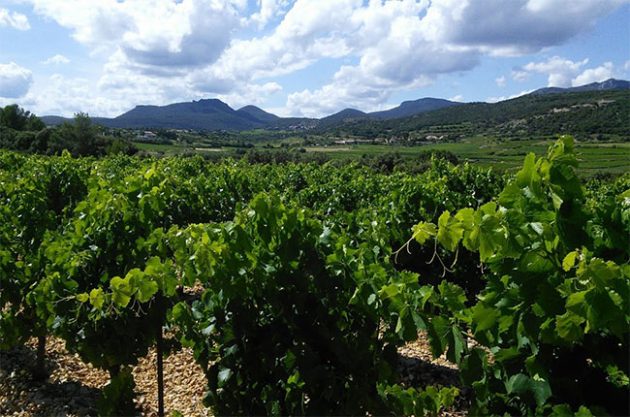Andrew Jefford on the Brexit squeeze facing wine…

Jefford on Monday: The ethnologist in the cellar
Andrew Jefford visits an ‘artisanal co-operative’ in Languedoc, and learns how it saved its village.
Co-operatives are such a familiar part of the wine landscape, particularly in Europe, that we tend to forget what extraordinary hybrids they are: not just commercial entitities with a social dimension, but collections of individual entrepreneurs who have agreed to pool resources and efface individuality for the common good.
Nowadays, these mixed roles prove challenging: institutions of vital social significance in their villages often struggle to make commercial headway, not least because pride and ambition are diluted in the muddy waters of the communal bath. Here’s the fascinating story of what one Languedoc co-operative resolved to do about these challenges.
It decided to hire an ethnologist.

Bernard Pallisé, director of Castelbarry, Coopérative Artisanale à Montpeyroux. Credit: Andrew Jefford.
‘I noticed that no one was proud of being in a co-operative.’
The co-operative in question was formerly known as the Cave de Montpeyroux; now it’s known as ‘CastelBarry, Coopérative Artisanale à Montpeyroux’. “I’m convinced of the value of co-operation,” says director Bernard Pallisé. “But I noticed that no one was proud of being in a co-operative. The members didn’t want the word appearing on labels, for example. I worried that in a decade, we’d no longer be relevant because we wouldn’t be able to make the most of what we’ve got.” A local retired policeman had begun a history study on the village, and it gave Pallisé the idea of creating a project based around the ‘societal memory’ of the co-operative. So, in 2011, he contacted ethnologist Marie-Ange Lasmènes.
She recorded lengthy interviews with present and former members of the co-operative and, working with photographer Alain Tendero, turned her work both into an exhibition and a short book publication. “When I presented the book to the members just before Christmas 2014,” remembers Pallisé, “three-quarters of them were in tears.” The project not only had a motivating and galvanising effect on members, but it also inspired Marie-Ange Lasmènes herself to become ‘an independent ethnologist’. She has since worked with the cooperative at Puisseguin-St Emilion and with Plaimont Producteurs, too. Further books are planned, and perhaps an exhibition at Bordeaux’s Cité du Vin.

The Montpeyroux landscape. Credit: Andrew Jefford.
Montpeyroux (the name comes from Mont Pierreux — ‘Stony Mountain’) not only has a historical appellation of its own within the Languedoc AOC, but it also lies in the newer quality appellation of Terrasses du Larzac. The origins of the village (a collection of five hamlets) are three Roman villas, dominated by a huge C12 walled enclosure on the hillside up above known as the Castellas de Montpeyroux. The cooperative’s name is a contraction of Castellas and St Martin du Barry, a celebrated chapel in one of the hamlets. The summits of Mont St Baudile and the Montagne de la Seranne lie above, and the Cévennes beyond. It’s rugged upland country.
Phylloxera heralded a chapter of disasters in Languedoc: over-production, fraud, the First World War, competition from Algeria. The resulting crisis brought half a million demonstrators on to the streets of Montpellier in 1907. Inspired by the leadership of socialist pioneer Jean Jaurès, many Languedoc villages began to form co-operatives from 1905 onwards – but not Montpeyroux, which was a village divided into ‘red’ left-wing republicans and ‘white’ monarchist conservatives. The village had two schools, two cafés, two hairdressers and two bakers … to serve each section of the community. “You also had social divisions,” added Lasmènes, “between the small producers and those who owned a lot of land, and there were further divisions between the believers (whether Catholic or Protestant) and the non-believers, the secularists”. An initiative to form a co-operative in the 1930s collapsed because this river of divisions proved unbridgeable.
After World War Two, continued Lasmènes, “the vineyard was in a poor state. But agriculture here is monoculture: if the vineyards sank, the whole village was going to sink with them.” Wine-making conditions were atrocious – tiny cellars where old casks shared space with donkeys and mules and their droppings. Casks leaked or gave way; wines oxidised or turned acetic. The purchasers were local négociants who exploited the weakness of the producers.
The smaller-scale producers realised that they had to form a co-operative to survive (it came into being in 1949). At first, the larger producers wanted to spurn it – but thanks to a visionary village mayor (Michel Teisserenc) and a retired general called Alfred Guyomar who agreed to bring all of his harvest to the co-op cellar and act as its first president, they were gradually won over. What Lasmènes shows is that the cooperative not only kept wine-production alive in this hilly vineyard area where bulk production was never an option, but it also gradually healed the fractures in the village itself. It taught the villagers that they could not only work successfully together, but that modest prosperity could even beckon via communal action.
Nowadays the village is a very different place – but it’s still surviving and prospering, and the co-operative is still a lynchpin of village life. There are outstanding independent producers today, notably Sylvain Fadat, but the multiple challenges of viticulture, winemaking and wine-selling are not for everyone; more and more growers are part-timers in any case, with other jobs. The cooperative still has 110 members and 500 ha; unusually for the Languedoc, it produces more AOC wine than IGP wine, with 50 per cent exports (Majestic is a leading retailer of the co-operative’s wines in the UK). Some notes are given below.
I’ll leave the last word to grower and co-operative member Yvon Carceller, who inherited 10 ha from his father and now has 26 ha. “The cooperative was the treasure of the village and for me, it still is. Of course, like everyone, there are times when you want to chuck it all in. But somehow you recognise that it’s not too bad, and that it brings you a bit of freedom. You’re your own boss; you don’t have fixed hours. Afterwards, when you have to treat the vines, it doesn’t matter if it’s Sunday or not: you’ve got to go. That’s part of the deal. I could have an easier life, but there you are, it’s in my mentality, I’ve always wanted to grow the domain. We’ll leave it to our children. They’ll do what they want with it, but at least they’ll have a patrimony. Good vineyards will always have value.”
A CastelBarry selection
Excès Rosé, Languedoc 2016
A pale, screwcap rosé with a stylish frosted bottle, this ‘extrème gris’ is a night-harvested blend of Grenache and Cinsault. The scents are softly peachy, and the flavours are vivid, lively, soft and quenching. The sappy, vinous finish would make it food-friendly, too. Outstanding at its €5.80 price point. 88 points.
Roquefeuil, Terrasses du Larzac 2015
At just €7 from the cooperative, this is another great value red as well as a bargain Carignan-led blend from the Terrasses du Larzac appellation. The Carignan is joined by Syrah and Grenache grown on fine-pebbled limestone gravettes, and the wine has fresh dark fruit, bright acidity, vivid energy and a little faint grip to lend sobriety and food-friendliness to the finish. 88
Les Murets, Languedoc Montpeyroux 2015
This dark black-red blend of selected parcels of Grenache, Syrah and Carignan smells of spice and the citrus-grove notes typical of Languedoc Syrah. On the palate, it’s firm, bright, lively and zesty. The fruit is full of high drama and the perfumed style lasts all the way to the finish. 90
Les Remparts, Languedoc Montpeyroux 2015
The blend is the same, but the proportions are different: Syrah accounts for 60 per cent here with 20 per cent for each for Grenache and Carignan. It’s a stricter parcel selection, and the wine is aged in demi-muids (one-third new) for a year. The scents are both sweeter, yet more freshly fruity, too, with a cade or juniper cast to them. An impressive red with impact, depth, breadth and strike, as well as a sense of place. 91
More Andrew Jefford columns on Decanter.com:
Don’t believe everything you’ve heard…
Andrew Jefford on the hunt for value in Piedmont…
A brief history of French wine…
